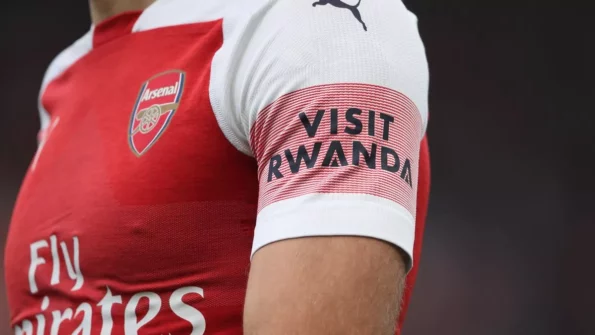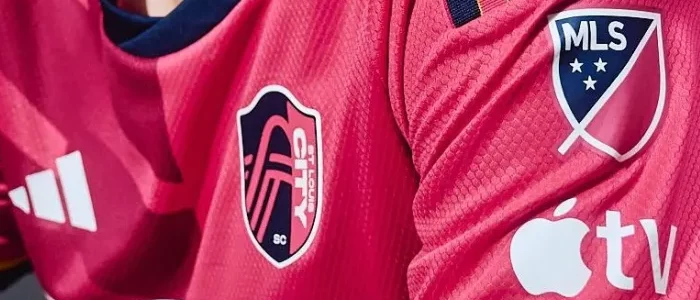From Barcelona’s iconic stripes to Manchester United’s devilish red, soccer jerseys have become more than just a symbol of allegiance. Keen observers may notice an additional element adorning these kits – sponsors’ logos. Have you ever wondered why soccer jerseys have sponsors on them? Join us as we delve into this intriguing phenomenon that has revolutionized the world of football!
Introduction
Soccer is undeniably one of the most popular sports globally. With an estimated 4 billion fans worldwide, it’s no surprise that soccer is also a multi-billion dollar industry. From lucrative television deals to merchandise sales, there are various ways for clubs and players to earn significant revenues from this beloved sport. One such way is through jersey sponsorships.
Before delving into why soccer jerseys have sponsors on them, it’s essential to understand what a sponsorship entails. In simple terms, sponsorship is when a company gives money to an organization or person in exchange for advertising their products or services. In soccer, this usually takes the form of having a company’s logo displayed prominently on the front or back of a team’s jersey.
History of Sponsorship in Soccer
Soccer sponsorship began in the late 1800s as clubs sought financial backing from businesses and wealthy individuals. In exchange for their financial contributions, these sponsors would have their names or logos displayed on team jerseys or around the stadium during matches. This form of sponsorship was mainly seen as a way for teams to cover their expenses and improve their facilities.
However, it wasn’t until the mid-20th century that sponsorships in soccer truly began to take shape. In 1956, German club Eintracht Braunschweig became one of the first teams to feature a sponsor’s name on their jerseys when they signed a deal with chocolate company Helmuth Schwarz AG. This sparked a trend across Europe, with other clubs quickly following suit.
The 1970s saw an increase in commercialization and marketing in soccer, which led to more prominent sponsorships deals being struck between clubs and companies. English club Arsenal signed a record-breaking sponsorship deal with Japanese electrical company JVC in 1981, setting a precedent for future sponsorships in terms of scale and revenue.
As television coverage of soccer expanded globally in the 199 0s, the sport became a more attractive platform for companies to advertise their products and services. This led to an influx of larger and more lucrative sponsorship deals in soccer, especially in major leagues such as the English Premier League and the Spanish La Liga.

In the 21st century, sponsorships have become an integral part of soccer, with almost all professional clubs having multiple sponsors associated with them. These sponsors range from global brands such as Nike and Adidas to local businesses looking to gain exposure through the sport’s popularity.
Sponsorship has also evolved beyond just having a company’s name on a team jersey or around the stadium. In modern times, sponsorships can include a wide range of activities such as product endorsements by players, digital advertising, and social media campaigns.
Why Do Teams Have Sponsors?
Teams having sponsors on their jerseys is a common sight in the world of sports, especially in soccer. You may have noticed that almost every professional soccer team has a sponsor’s logo prominently displayed on their jerseys. But have you ever wondered why teams have sponsors? In this section, we will explore the reasons behind teams having sponsors on their jerseys.
1. Financial Benefits
One of the main reasons why teams have sponsors on their jerseys is financial benefits. Sponsors give teams money to cover expenses like training, equipment, travel, and player salaries. With the increasing popularity of sports like soccer, it has become extremely expensive to maintain and run a professional team. Hence, sponsorship deals are crucial in helping teams stay financially stable.
2. Brand Exposure
Another significant reason for teams having sponsors is brand exposure. Soccer is one of the most popular sports globally and attracts millions of viewers worldwide. By sponsoring a team’s jersey, brands can gain massive exposure through live broadcasts, match highlights, social media posts by fans and players, and merchandise sales.
The more prominent the team’s profile or success rate is, the greater brand exposure they can offer to their sponsors. It gives companies an opportunity to showcase their logo to millions of potential customers without spending an exorbitant amount on traditional advertising methods.
3. Team Partnerships
Sponsorship deals also create partnerships between teams and companies that share similar values or target audiences. This allows teams and sponsors to collaborate on various marketing campaigns, events, and promotions that can benefit both parties.

For example, a sportswear brand sponsoring a team’s jersey can also offer their products exclusively to the team’s players and fans. It not only promotes the sponsor’s brand but also helps in building a stronger relationship between the two entities.
4. Competitive Advantage
In some cases, sponsorship deals can give teams a competitive advantage over their rivals. With the additional financial resources, teams can invest in better players, coaches, training facilities, and other resources that can improve their performance on the field. This competitive edge can attract more fans and generate more revenue for both the team and the sponsor.
The Impact of Sponsorship on Soccer
Sponsorship has become an integral part of modern soccer, with almost every team sporting logos and brand names on their jerseys. But what exactly is the impact of these sponsorships on the sport? In this section, we will discuss the various ways in which sponsorship affects soccer.
1. Financial Stability for Clubs and Leagues
One of the biggest impacts of sponsorship on soccer is its financial stability. With lucrative deals from sponsors, clubs and leagues are able to generate significant revenue that can be used for player transfers, stadium upgrades, and other expenses. This financial stability allows teams to invest in top players and compete at a higher level, creating a more competitive environment in the sport.
2. Increased Exposure
Sponsorship also brings increased exposure to both clubs and brands involved. By having their logo displayed prominently on jerseys, sponsors are able to reach a global audience through televised matches and online coverage. This exposure not only benefits the sponsoring brand but also helps increase awareness for smaller or lesser-known clubs.
3. Opportunities for Player Development
With additional funding from sponsorships, clubs are able to invest in youth development programs and facilities. This provides opportunities for young players to develop their skills and potentially make it into the first team squad. Sponsorships thus play a crucial role in nurturing future talent in soccer.

4. Influence on Team Transfers
In some cases, sponsorship deals can have an impact on team transfers as well. Sponsors may request that certain players be included or excluded from a team’s roster as part of their sponsorship agreement. This can lead to clubs making transfer decisions based on commercial rather than sporting considerations.
5. Pressure for Success
Sponsorship deals often come with performance-based incentives, which can put added pressure on teams and players to perform well. This pressure can be beneficial as it motivates teams to strive for success, but it can also have negative consequences if expectations are not met.
6. Commercialization of the Sport
Some argue that sponsorship has led to the commercialization of soccer, with more focus being placed on generating revenue rather than the spirit of the game. This can lead to concerns about the authenticity and integrity of the sport, as well as a potential imbalance between wealthy and less financially stable teams.
Conclusion
The inclusion of sponsors on soccer jerseys is a significant aspect of the sport’s global reach and influence. It not only provides financial support for teams and players but also increases brand exposure for companies. While some may argue that it takes away from the purity of the game, the presence of sponsors on soccer jerseys has become an integral part of modern football culture.
FAQs
1. Why don t international kits have sponsors?
The prohibition on showing sponsorship on the front of international jerseys serves to uphold the integrity of the tournament. As such, FIFA is also responsible for safeguarding the exclusivity of the official sponsors for the event.
2. Can you remove sponsors from football shirts?
To effortlessly remove any unwanted patches from your shirt, simply use a small amount of acetone and a cotton swab to gently rub the back of the affected area. Afterward, make sure to wash the shirt to prevent any potential damage from the acetone.
